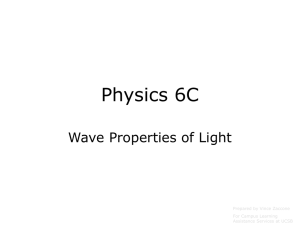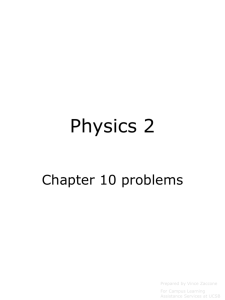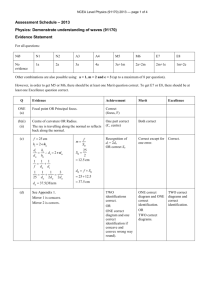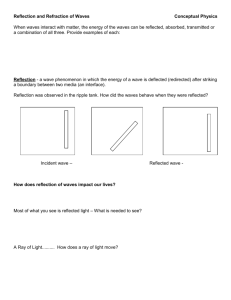Index of Refraction - UCSB Campus Learning Assistance Services
advertisement
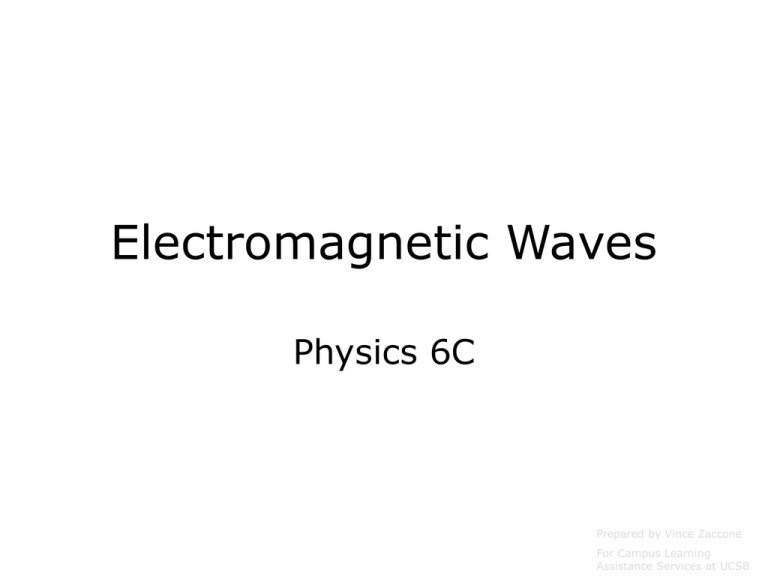
Electromagnetic Waves Physics 6C Prepared by Vince Zaccone For Campus Learning Assistance Services at UCSB Electromagnetic Waves Electromagnetic (EM) waves are produced by an alternating current in a wire. As the charges in the wire oscillate back and forth, the electric field around them oscillates as well, in turn producing an oscillating magnetic field. This magnetic field is always perpendicular to the electric field, and the EM wave propagates perpendicular to both the Eand B-fields. This gives us a right-hand-rule relating the directions of these 3 vectors: 1) Point the fingers of your right hand in the direction of the E-field 2) Curl them toward the B-field. 3) Stick out your thumb - it points in the direction of propagation. Click here for an EM wave animation Prepared by Vince Zaccone For Campus Learning Assistance Services at UCSB Like any other wave, we know the relationship between the wavelength and frequency, and the speed of propagation of the wave: vwave f Prepared by Vince Zaccone For Campus Learning Assistance Services at UCSB Like any other wave, we know the relationship between the wavelength and frequency, and the speed of propagation of the wave: vwave f In the case of EM waves, it turns out that the wave speed is the speed of light. So our formula for EM waves (in vacuum) is: c f ; c 3 108 m s Prepared by Vince Zaccone For Campus Learning Assistance Services at UCSB Like any other wave, we know the relationship between the wavelength and frequency, and the speed of propagation of the wave: vwave f In the case of EM waves, it turns out that the wave speed is the speed of light. So our formula for EM waves (in vacuum) is: c f ; c 3 108 m s It turns out that the speed of light is also the ratio of the strengths of the Electric and Magnetic fields in an EM wave. So we know that E=cB (in standard metric units) Prepared by Vince Zaccone For Campus Learning Assistance Services at UCSB Like any other wave, we know the relationship between the wavelength and frequency, and the speed of propagation of the wave: vwave f In the case of EM waves, it turns out that the wave speed is the speed of light. So our formula for EM waves (in vacuum) is: c f ; c 3 108 m s It turns out that the speed of light is also the ratio of the strengths of the Electric and Magnetic fields in an EM wave. So we know that E=cB (in standard metric units) The continuum of various wavelengths and frequencies for EM waves is called the Electromagnetic Spectrum Prepared by Vince Zaccone For Campus Learning Assistance Services at UCSB Examples: • Find the frequency of blue light with a wavelength of 460 nm. Prepared by Vince Zaccone For Campus Learning Assistance Services at UCSB Examples: • Find the frequency of blue light with a wavelength of 460 nm. 3 108 m c s c f f 6.5 1014Hz 460 109m Prepared by Vince Zaccone For Campus Learning Assistance Services at UCSB Examples: • Find the frequency of blue light with a wavelength of 460 nm. 3 108 m c s c f f 6.5 1014Hz 460 109m • A cell phone transmits at a frequency of 1.25x108 Hz. What is the wavelength of this EM wave? Prepared by Vince Zaccone For Campus Learning Assistance Services at UCSB Examples: • Find the frequency of blue light with a wavelength of 460 nm. 3 108 m c s c f f 6.5 1014Hz 460 109m • A cell phone transmits at a frequency of 1.25x108 Hz. What is the wavelength of this EM wave? 8m 3 10 c s c f 2.4m 8 f 1.25 10 Hz You will need to use this formula very often to convert back and forth between frequency and wavelength. Prepared by Vince Zaccone For Campus Learning Assistance Services at UCSB Energy and momentum in EM Waves Electromagnetic waves transport energy. The energy associated with a wave is stored in the oscillating electric and magnetic fields. We will find out later that the frequency of the wave determines the amount of energy that it carries. Since the EM wave is in 3-D, we need to measure the energy density (energy per unit volume). u 1 0E2 1 B2 2 20 We can also talk about the intensity of an EM wave (for light we would think of it as brightness). Just as for sound, intensity is measured as average power/area. The Poynting vector, S, describes the energy transported by the wave (S points in the direction of propagation of the wave). E B Intensity Sav max max 2 0 EM waves also carry momentum. This means that a ray of light can actually exert a force. To get the pressure exerted by a sinusoidal EM wave, just divide the intensity by the speed of light. Radiation Sav c Pr essure Check out example 23.5 on page 771 of your textbook for a solar sail example that should help with your homework. Prepared by Vince Zaccone For Campus Learning Assistance Services at UCSB Reflection and Refraction When an EM wave encounters an interface between two materials it will generally be partially reflected and partially transmitted (refracted). The reflected ray makes the same angle as the incident (incoming) ray. Measure the angles from the NORMAL (perpendicular) to the interface. NORMAL LINE Incident ray material a Reflected ray θa θr material b θb Refracted ray Prepared by Vince Zaccone For Campus Learning Assistance Services at UCSB EM waves in vacuum travel at the speed of light, c = 3x108 m/s In any material medium (glass, water, air, etc.) light travels more slowly. This is called REFRACTION, and it explains why the light ray bends. Every material has a different Index of Refraction that describes the speed of light in that material medium: Index of Refraction c n v Speed of light in vacuum Speed of light in the material Since light always travels more slowly through a material medium, the index is always greater than 1. Our rule for finding the angle of the refracted ray is called Snell’s Law: na sin(a) nb sin(b) Prepared by Vince Zaccone For Campus Learning Assistance Services at UCSB Example: A beam of light in air enters water at an angle of 60° to the normal. Find the angle of refraction. The index of refraction of water is 1.33. Prepared by Vince Zaccone For Campus Learning Assistance Services at UCSB Example: A beam of light in air enters water at an angle of 60° to the normal. Find the angle of refraction. The index of refraction of water is 1.33. Incident ray Air na=1 Water nb=1.33 Reflected ray 60° θr Θb=? Refracted ray Prepared by Vince Zaccone For Campus Learning Assistance Services at UCSB Example: A beam of light in air enters water at an angle of 60° to the normal. Find the angle of refraction. The index of refraction of water is 1.33. na sin(a) nb sin(b) Incident ray Air na=1 Water nb=1.33 Reflected ray 60° θr Θb=? Refracted ray Prepared by Vince Zaccone For Campus Learning Assistance Services at UCSB Example: A beam of light in air enters water at an angle of 60° to the normal. Find the angle of refraction. The index of refraction of water is 1.33. na sin(a) nb sin(b ) (1) sin(60 ) (1.33) sin(b ) sin(60 ) 1 sin(60 ) sin(b ) b sin 40.6 1.33 1.33 Incident ray Air na=1 Water nb=1.33 Reflected ray 60° θr Θb=? Refracted ray Prepared by Vince Zaccone For Campus Learning Assistance Services at UCSB Total Internal Reflection When light enters a medium with a higher index of refraction it will bend toward the normal (the angle gets smaller). When light enters a medium with lower index (e.g. from water to air) then it will bend away from the normal (the angle gets larger). This creates an interesting possibility – what if the angle gets so large that the light ray is not transmitted at all? If the refracted angle is larger than 90° we have this situation – it is called Total Internal Reflection (make sure that name makes sense to you). In the diagram below Ray #1 has both a reflection and a refraction, while Ray #2 is totally reflected. The incidence angle for Ray #2 is larger than the “critical angle” for total internal reflection. To find this critical angle, simply set the refracted angle to 90° in Snell’s Law. Refracted Ray #1 Air nb=1 Water na=1.33 Ray #2 Reflected Ray #2 Ray #1 Reflected Ray #1 Prepared by Vince Zaccone For Campus Learning Assistance Services at UCSB Dispersion This is the exception to the rule that says that all waves in a given medium travel at the same speed (we learned this for sound waves in a previous chapter). In a material medium, EM waves exhibit a phenomenon called DISPERSION, where the index of refraction depends on the frequency of the light. Higher frequencies correspond to a higher index, and thus are refracted more than lower frequencies. This effect is why we have rainbows! (the drops of water in the air act as tiny prisms) Prepared by Vince Zaccone Dispersion of EM waves - aural interpretation by Pink Floyd For Campus Learning Assistance Services at UCSB Polarization The Polarization of an EM wave is defined to be the direction of its Electric field vector. EM waves (or light) can be passed through a filter (polarizer) to select for a particular polarization direction. This will cut down the intensity (brightness) of the light based on the following formula: I Imax cos( )2 Polarizers can be placed in sequence to adjust the intensity and polarization of light. The most obvious example is dark sunglasses, where 2 filters are placed at 90° to each other, blocking out most of the light (the formula would say all the light is blocked). Prepared by Vince Zaccone For Campus Learning Assistance Services at UCSB Polarization Details about polarization: Typical light sources are unpolarized, which means the EM waves are not oriented in any particular direction (sunlight behaves this way). When unpolarized light passes through a polarizer, half of its intensity is blocked, and the transmitted light is now polarized in the direction selected by the filter. Example Problem • Sunlight passes through 2 polarizers which are oriented at 60° relative to each other. How much of the original sunlight intensity is transmitted? Prepared by Vince Zaccone For Campus Learning Assistance Services at UCSB Polarization Details about polarization: Typical light sources are unpolarized, which means the EM waves are not oriented in any particular direction (sunlight behaves this way). When unpolarized light passes through a polarizer, half of its intensity is blocked, and the transmitted light is now polarized in the direction selected by the filter. Example Problem • Sunlight passes through 2 polarizers which are oriented at 60° relative to each other. How much of the original sunlight intensity is transmitted? 2 1 Ifinal Isun cos(60 ) 1 Isun 2 8 1 4 Click this link for a java applet with polarizers. Prepared by Vince Zaccone For Campus Learning Assistance Services at UCSB Polarization Details about polarization: Typical light sources are unpolarized, which means the EM waves are not oriented in any particular direction (sunlight behaves this way). When unpolarized light passes through a polarizer, half of its intensity is blocked, and the transmitted light is now polarized in the direction selected by the filter. Reflected light is (at least partially) polarized parallel to the reflecting surface. A good example is sunlight reflecting from the water. Fishermen wear polarized sunglasses to block the reflected sunlight, giving them a better view of objects beneath the surface. Prepared by Vince Zaccone For Campus Learning Assistance Services at UCSB
